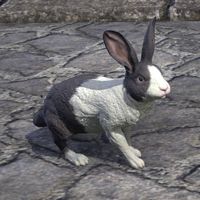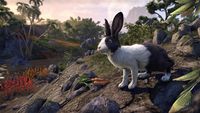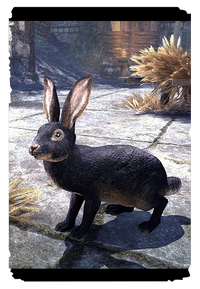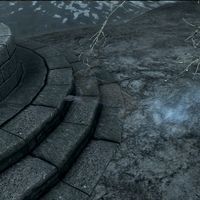Lore:Hare
| Hares | |||
|---|---|---|---|
 A Pale Pass Mountain Hare (ESO) A Pale Pass Mountain Hare (ESO)
|
|||
| Type | Beast (Mammal) | ||
| Range | Atmora, Cyrodiil, High Rock, Skyrim, Summerset Isles | ||
| Appears in | |||
Hares are small, long-eared animals similar to rabbits, though they are sometimes incorrectly conflated with them by the denizens of Tamriel.[1] They can be found in Summserset Isles,[2] Skyrim,[3] High Rock,[4] and Cyrodiil.[1] Hares are also tangentially associated with the Daedric Princes Hermaeus Mora and Hircine.[5][6]
Variants[edit]
Hares come in a variety of fur colors, including shades of brown and grey,[7] as well as white with black spots and solid black.[1][3]
Pale Pass Mountain Hares are found in the region of Pale Pass in the Jerall Mountains of northern Cyrodiil. They were often sought out and captured by enterprising merchants and then sold, sometimes inaccurately referred to as bunnies.[1]
The Understone Obsidian Hares, common in the Reach and named after Markarth's Understone Keep, were known to be kept as a pet by some Reachfolk. Similarly to Pale Pass Mountain Hares they were ocassionally incorrectly labeled as rabbits.[3]
Culture[edit]
General[edit]
Hares are sometimes associated with luck and have lent their name to various businesses.[8] They are frequently hunted for their meat,[9][7] and prized for their pelts.[4] Hare meat is used in a variety of dishes, including being served grilled or prepared with garlic sauce.[9][10] Idioms comparing hares and tortoises to describe quick and slow individuals were in use.[11] The term "hare-brained" was used across many races and cultures of Tamriel, including the Altmer and the Khajiit, to describe foolish or reckless individuals.[12][13] Hares were also featured in jokes, such as: What do you call a line of rabbits hopping backward? A receding hare-line.[14]
Altmer[edit]
Hares were found in the Summerset Isles, where some dogs were known to chase them.[2] Idioms such as "quick as a spooked hare" were sometimes used to describe swift individuals.[15]
Imperials[edit]
Idioms involving hares, such as "coursed down like a hare" were present in Imperial culture.[16]
Nords[edit]
Idioms involving hares, such as "I run like a hare from the hound" were present in Nordic culture.[17] Nords were known for shoes designed to track hares through the craggy terrain.[18]
Orcs[edit]
Orcs were known to craft shoes from hare leather, though they generally expressed a preference for echaterre leather.[4] This general sentiment is echoed in various texts, including a message authored by Eveli Sharp-Arrow.[19][20]
Reachfolk[edit]
One Reachfolk saying, The swift hare survives where the dull ox cannot, was used to emphasize the importance of a warrior's quickness.[21] They also sometimes described someone as aspooked hare, meaning fast and and cautious. "Hare-bladder coward" was one of the insults used by the Reachfolk.[22] Some Reachfolk would sometimes compare a timid person to a hare turned human by a witch.[23]
Daedra[edit]
Hares are mentioned frequently in the context of the Daedra. Spirit of the Daedra, a tome authored by a Daedric entity, compares the Daedra's view of mortals to the way men and mer regard animals like hares or foxes. This perspective, focused on both the cunning and fragility of prey, was echoed by Molag Bal himself.[24][25] The hare is also closely associated with Hermaeus Mora, who is said to assume this form,[5] as well as with Hircine, who often designates the target of Great Hunt as the Hare.[6]
Hermaeus Mora[edit]
In one Nordic myth surrounding Ysgramor, Herma-Mora took the form of a hare. The story remained speak of Ysgramor and Herma-Mora's hare.[5][26]
Hircine[edit]
The Great Hunt, a sacred event dedicated to Hircine, is a grand chase in which the chosen prey is designated as the Hare, named after the animal hunted by the mortals.[6][27] The term refers to anything that is hunted, including other animals like indriks,[28][29] and even people.[30][31] According to the rites of the Hunt, the Hare must be given at least a small chance of escape.[32][33]
Some of Hircine's werewolf followers, such as Vykosa the Ascendant, viewed their condition as that of an eternal Hare, forever hunted in an endless chase.[34] Hircine himself referred to some mortals as hares, even when they were not targets of the Great Hunt.[35]
Gallery[edit]
See Also[edit]
- For game-specific information, see the SkyrimCC and Elder Scrolls Online articles.
References[edit]
- ^ a b c d Pale Pass Mountain Hare's pet appearance and description in ESO
- ^ a b Kinlady Ilunsare's dialogue in ESO: Summerset
- ^ a b c Understone Obsidian Hare's description and appearance in ESO
- ^ a b c Brogdul's dialogue in ESO: Orsinium
- ^ a b c Fragmentae Abyssum Hermaeus Morus
- ^ a b c The Posting of the Hunt
- ^ a b Carcass, Brown Hare, and Carcass, Grey Hare in ESO
- ^ Lucky Hare Wares in ESO
- ^ a b Grilled Hare and Hare in Garlic Sauce recipes in ESO
- ^ Lord of Souls — Greg Keyes
- ^ Anora's Journal — Anora
- ^ Tufeh's dialogue in ESO: The Deadlands
- ^ Vinilsare's dialogue in ESO: High Isle
- ^ Jokes in Castles
- ^ Jurisreeve Soravil's dialogue in ESO: Summerset
- ^ Drake of Blades's dialogue in ESO: Imperial City
- ^ Flight from the Thalmor — Hadrik Oaken-Heart
- ^ Hare-Tracker's Boots in ESO: Markarth
- ^ The Wood Elf's Message
- ^ Little Echatere — Eveli Sharp-Arrow
- ^ Aydolan's dialogue in ESO: Markarth
- ^ Arana's dialogue in ESO: Markarth
- ^ Eslyn's dialogue in ESO: Markarth
- ^ Spirit of the Daedra
- ^ Molag Bal's dialogue in ESO
- ^ Hare and Fox Bundle in ESO
- ^ The Huntsman Prince — Hanu of the Zainab Tribe
- ^ Hanu's dialogue in ESO: Wolfhunter
- ^ An Unusual Hare — Maveld Bearfang
- ^ Aspects of Lord Hircine — Juno Procillus, Academy of Chorrol
- ^ Dagrund the Bulky's dialogue in ESO: Wolfhunter
- ^ Letter from Balaherne — Balaherne
- ^ Hircine's Haunt's loading screen text in ESO
- ^ The Hungry Cat's Curse — Vykosa the Ascendant
- ^ Hircine's dialogue in Oblivion



